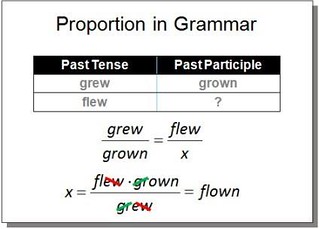Inspired by calculus: Tuesday math circles, Weeks 4 and 5
These are notes about a math circle for kids ages six to ten. Thank you for your write-ups, Kristin and Sally! All photos are in the set on Flickr.
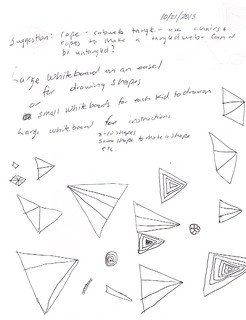
This time, I talk about several activities that did not work as I hoped. In hindsight, I think I know how to fix the experiences, and what to avoid in the future. I am sharing these notes to help parents and designers, and to ask for input. Please tell me what you think on how to improve, and ask your kids. Even knowing such experiences are necessary for innovation, it’s hard for me to write about experiments that fizzle.
There is an endless list of design issues that make activities go south, for example, the room is too small, the rules are too numerous, not enough storytelling to feed the imagination, manipulatives distracting from ideas, and so on. There are many checks and balances between too much and too little of this and that. But if children have enough freedom, and sympathetic adults, most of the time they just self-regulate in all these aspects!

There are three levels of freedom in activities I choose or design. As a side note, the lowest level is more freedom that many textbooks or classes ever give students.
- Problem Solving. Students receive problems with known answers. They have the freedom to use, develop, or acquire any method of solving the problems.
- Inquiry. Students receive open-ended problems with infinite possible answers. They have the freedom to interpret the nature of answers, as well as choose methods of solving the problems.
- Self-Organized Learning. Students choose (or accept an offer of) a broad starting area, and pose problems or projects within that area. They have the freedom to make their own problems, to interpret the nature of answers, and to choose methods of solving their problems.
For example, the task of drawing infinity is at the third level, and the task of drawing Hotel Infinity so that all infinity rooms fit on paper is at the second level. I need to try harder for more third-level tasks. Impose too many restrictions (as in the shape tasks below), and you are in the first level territory, or even lower! Ouch!
Shape out of similar shapes. The goal of this puzzle is to connect partitioning and grouping. We have been doing a lot of partitioning activities, splitting shapes into infinitely many pieces. Can kids reverse the process? I asked kids to make a shape out of similar shapes, but not infinitely many of them. This was an engaging, meaningful activity that I will use again. The fact it’s rather challenging, and takes a long time, is surprising, since we did a lot of “take shape apart” activities before. But any sort of reversal is challenging for kids. For example, if you introduce addition separately from subtraction, children find subtraction much harder to do. Taking square roots is often harder than squaring. I want kids to see seamless connections between partitioning and grouping, for example, positive and negative powers of ten, or fractions and multiples.

I loved that some kids made shapes out of one single shape, for example, a square made out of one square. This is an example of an extreme case. Looking at extreme cases is a valuable math practice, because you often notice new properties when you look at extreme cases. Kids who love to find loopholes in rules are especially strong at this math practice. Support it.
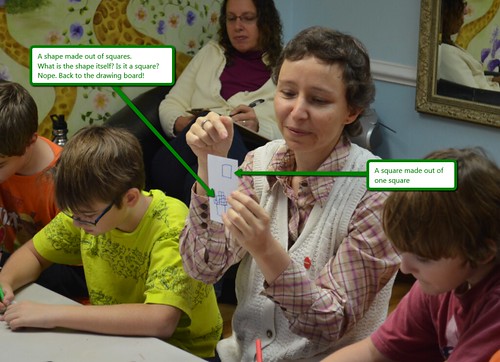
Another emergent behavior was to make “zoom shapes” or “frame shapes” that looked like nested dolls. I have tried the “shape out of shapes” activity with four groups of kids so far, and this idea came up in all four.
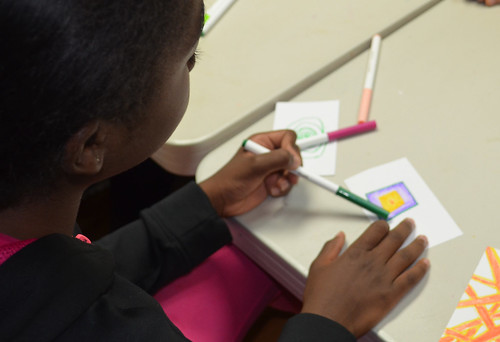
There are two strong math principles behind it. First, it works with absolutely any shape; the idea is powerful because it’s universal. Mathematicians always strife to make conjectures or rules apply to as many things at once as possible. That’s how they figure out how to take square roots of negative numbers, or divide by zero. The second powerful principle is from calculus. A nested shape consists of infinitely many infinitesimal thin strips. The same idea of thin strips is behind numeric integration. I don’t know yet how to turn this into a separate activity, but I will keep thinking about it. Maybe when we get to integration!
Formal rules: shape out of shapes. I told kids the next round of the puzzle will be more challenging. Here were the restriction to up the challenge:
- The big shape has to be the same type (e.g. a rectangle or a triangle) as the little shapes.
- No gaps or overlaps!
- The big shape is made out of two to ten little shapes.
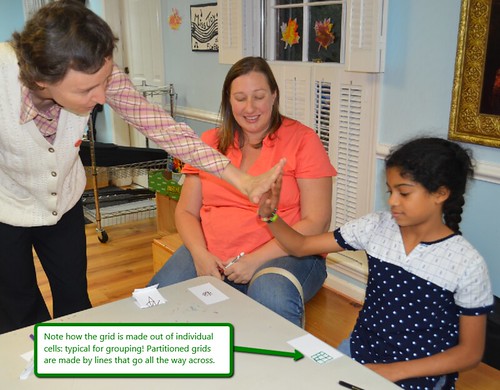
The goal of the restrictions was to approach a particular math topic, namely, decimal fractions and the corresponding fractions in different bases. I wanted to share my fascination with things like .9999…=1 and the whole idea of positional system viewed from the calculus perspective. But these ideas, in the form I tried to approach them, required rather narrow and symbolic path to them. For example, I narrowed down the requirement to make big shapes out of small enough number of little shapes, because I wanted kids to do the sub-divisions again and again and again. This I could not communicate, and so it came across nitpicky and random, and kids just did not follow. They continued with various doodles of infinitesimal shapes.

I think they suspected I am trying to take them out of the realm of calculus and into the realm of arithmetic, and resisted that. The three rules became more tedious than challenging. Even the idea of making a movie about the shapes was only momentarily exciting.

Shapes out of shapes: now with the story and a maker component. The week after, I attempted to salvage the activity by adding two components that generally make activities more alive. First, we tied it to the story of Hotel Infinity. Kids were to draw a group of 1-3 aliens that would go into one of the three hotels. Then kids were to make up a symbol for the type of the rooms within the hotel. It worked better, because stories and making things up are good to have, but there is still room for improvement.
Minuses: making up symbols for counting numbers wasn’t really enough of a maker activity for calculus, and wasn’t puzzling enough to make for strong problem-solving. Conclusion: increase the problem-solving (puzzle) component; clarify and strengthen the idea of symbols; and scaffold children’s attention to the development of the positional systems via a series of puzzles that can lead to better discussions of infinitesimals. Here are my notes for the future:
- First, go on a scavenger hunt for all sorts of symbols. Just telling kids “make up alien symbols” was too sudden, and required too much backtracking into what symbols are, anyway! But hunting for symbols is a fun activity for people of all ages. I’ve done it with groups before. My teen has done it in a philosophy class.
- Stick with one hotel at a time, but invite kids to pick one room instead of a group of rooms. I’ve done a variation of this with a group of kids at the MusArt camp, and it worked fast enough (~10 minutes) and was fun enough that they wanted to keep going longer than I did. So I could introduce multiple hotels next. This would lead kids into their own versions of positional systems with symbols. I think starting with Base 2 would work the best, because you only need to indicate the level within the hotel (the position) – like using 1 in a particular position in a binary number. Then we could make the puzzle harder by using Base 3, Base 5, Base 10… And ask kids to contribute shape ideas when hotels are built, so we can use someone’s favorite shapes.
- Add a stronger maker component focused on sequences and series, infinitesimals, or other related calculus ideas. I am not sure how to do this, yet. I think creating your own sequence may be engaging. At least if you judge by thousands upon thousands of submissions in the Online Encyclopedia of Integer Sequences. I want kids to be creative with what they make – using drawings and models, not just numbers. It’s not clear to me yet how to promote this aspect.
I later noticed that several kids used spatial symbols, for example, Chris used a planet with a ring for the sixths level (hint: Saturn), Ben used a flag to mean the top level, and Calvin used up-arrows to show that the alien can change its size and also needs to occupy the top level.
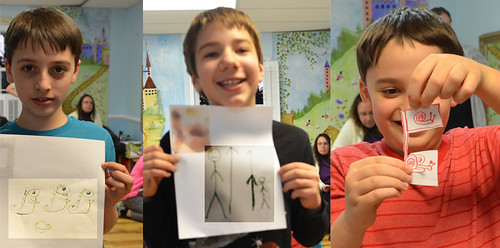
Jason and Kim both used objects to indicate the third level; they discuss their work with one another a lot, and sometimes their ideas develop together.
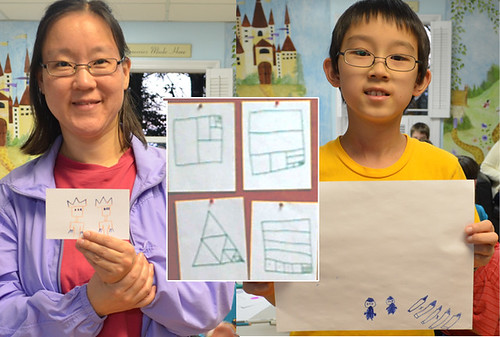
Other kids used number or quantity symbols: Maxime x4, Elena the mirror 1, Kaiya +2 and Asiyah two pumpkins. Stephen used 1 2 3 to indicate the third level.
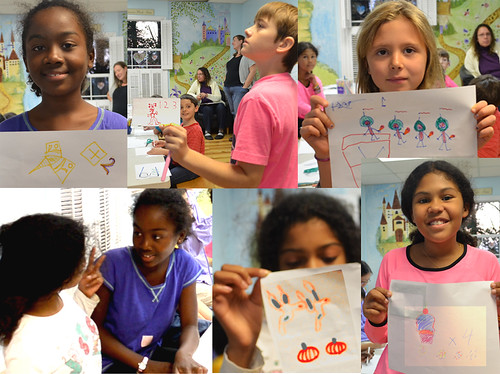
It is a joy to see ideas spread. I am happy the kids pinpointed the essential idea that levels of the power structure can be numbered, and came up with a variety of symbols. At home: come up with symbols for various ideas.
The Zeno walk. Can you reach the camera? What about all the infinity halves you have to pass? Zeno paradoxes are resolved through calculus. For example, the arrow paradox we roleplayed is resolved if you realize infinitely many time intervals can add up to a finite time total. And kids did explain this idea, in their own words. They weren’t very surprised, either. Some of the calculus ideas that baffle adults seem easy, almost trivial to kids. Wow.
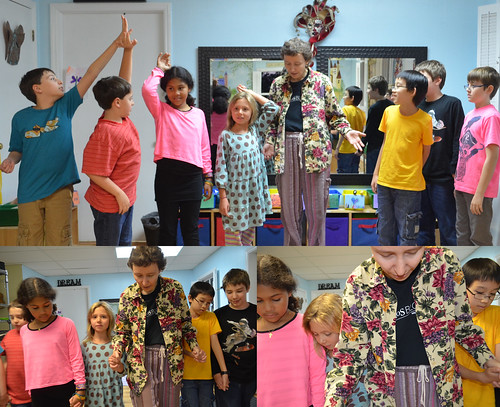
Interactive: Universcale. I think the above activities helped kids to engage with the Universcale interactive at a deeper level. At home: find systems that zoom in and out, split or group, such as measurement units.

Posted in Grow
Calculus, 43 chicken McNuggets and DIY math circles: Newsletter October 30
Got this from a friend? Subscribe! I am Moby Snoodles, and this is my newsletter. Send me your requests, questions, and comments at moby@moebiusnoodles.com 
Blogs and networks
David Cordeiro’s review on Amazon captures a major reason we wrote Moebius Noodles: Adventurous Math for the Playground Crowd:
So often, young kids’ first exposure to math is through arithmetic. This book opens up a whole new world of play as it relates to math and/or math as it relates to play! Either way, kids will learn to love the math they find around them and their curiosity will be ignited.
Please help others discover Moebius Noodles! Review it on Amazon. We are continuing our calculus-inspired local Math Circles. If you are interested in trying these activities with your 4-10 year olds, read the detailed reviews from each session on our blog.  We like ending each Math Circle meeting with a beautiful mathematical video. Kids enjoy them and frequently describe the math they see as “unreal”, “hypnotic”, “beautiful” and, of course, “weird” and “funny”.
We like ending each Math Circle meeting with a beautiful mathematical video. Kids enjoy them and frequently describe the math they see as “unreal”, “hypnotic”, “beautiful” and, of course, “weird” and “funny”. 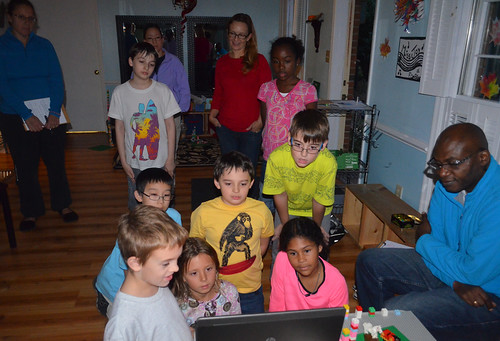 A short video is perfect for inviting kids into a mathematical discussion, or to create their own math. That is why we frequently share such “invitations” on our Facebook page. The most recent video was Etereas, the study of dynamic shapes and curves. The ever-changing shapes kept Soodabeh’s 3-year old girl “watching it over and over”! Yelena McManaman’s 6-year old boy wanted to watch the video several times as well. He echoed Maria Droujkova’s FB comment: “It would be cool to make such “laser hoop” in physical space!” Does anyone know how?
A short video is perfect for inviting kids into a mathematical discussion, or to create their own math. That is why we frequently share such “invitations” on our Facebook page. The most recent video was Etereas, the study of dynamic shapes and curves. The ever-changing shapes kept Soodabeh’s 3-year old girl “watching it over and over”! Yelena McManaman’s 6-year old boy wanted to watch the video several times as well. He echoed Maria Droujkova’s FB comment: “It would be cool to make such “laser hoop” in physical space!” Does anyone know how?  Picture by (x, why?). For some reason there’s this general misconception that mathematicians do not have a good sense of humor, or none of their jokes are for “regular people”. That’s why we were happy to see this NPR interview about math and mathematicians of the widely popular Simpsons show. And we are collecting a series of Halloween comics and puns on Facebook.
Picture by (x, why?). For some reason there’s this general misconception that mathematicians do not have a good sense of humor, or none of their jokes are for “regular people”. That’s why we were happy to see this NPR interview about math and mathematicians of the widely popular Simpsons show. And we are collecting a series of Halloween comics and puns on Facebook.  Some puzzles are like visual math puns. Have you seen the one about the holes in the T-shirt? Have you tried it? We’ve received quite a few answers – 4, 6, 7, 8. What do you think? Your answer will depend on what you call “holes.” You may need different definitions for buttoning a shirt, taking an IQ test online, or reading a paper on topology! Do you know what a Frobenius number is? Big thanks to Eric Hamilton for sharing this 43 McNuggets video with us. Maria Droujkova recently appeared on The Renegade Writer’s daily newsletter with a simple math tip that can help you write more. Or just do more of anything else you need done. Here it is:
Some puzzles are like visual math puns. Have you seen the one about the holes in the T-shirt? Have you tried it? We’ve received quite a few answers – 4, 6, 7, 8. What do you think? Your answer will depend on what you call “holes.” You may need different definitions for buttoning a shirt, taking an IQ test online, or reading a paper on topology! Do you know what a Frobenius number is? Big thanks to Eric Hamilton for sharing this 43 McNuggets video with us. Maria Droujkova recently appeared on The Renegade Writer’s daily newsletter with a simple math tip that can help you write more. Or just do more of anything else you need done. Here it is:
- Estimate a task’s duration, for example, writing a paragraph, reading an article or putting away toys.
- Start a stopwatch (in another room, so you don’t keep checking)
- Finish the task and compare your time to your estimate. Prepare to be surprised.
It was so eye-opening! My estimates were off by orders of magnitude! No wonder I had a hard time getting anything done. I even started doing the time-estimation exercise for little household tasks: emptying the dishwasher, getting potatoes from the garage, hanging a picture… Again, my estimates were wildly off at first. Then I got better, and my life became so much smoother. Measuring similar tasks many times (so you are sure how long they take) makes you brave enough to work in short sprints between other tasks.
Events: Want a Math Circle for your kids?
Maria Droujkova was a distinguished guest at the ReinventED unconference at Black Mountain SOLE (Self-Organized Learning Environment). It was another gathering where many people asked if we know of Math Circles for young kids in their area. The bad news is, there are still very few Circles that invite young kids into deep math adventures. The good news is you can organize one! And there are probably local people who will be happy to help. Starting a Math Circle might sound scary, but we are building a support system to make it happen for you. For our next round of open online courses and publications, we need to hear from you. What are the biggest questions, concerns, and obstacles that prevent you from starting your own math circle? Write us at moby@moebiusnoodles.com
Sharing
You are welcome to share the contents of this newsletter online or in print. You can also remix and tweak anything as you wish, as long as you share your creations on the same terms. Please credit MoebiusNoodles.com More formally, we distribute all Moebius Noodles content under the Creative Commons Attribution-NonCommercial-ShareAlike license: CC BY-NC-SA ![]() Talk to you again on November 15th! Moby Snoodles, aka Yelena McManaman
Talk to you again on November 15th! Moby Snoodles, aka Yelena McManaman
Posted in Newsletter
Inspired by Calculus Thursday math circle, week 3
These are notes about our activities at the third meeting of the Math Circle. The main goals of activities were to contrast linear and non-linear growth, and to approximate curves with straight lines. Children’s activities brought my attention to three other ideas: consistency of patterns; differences; and measurement.
Here are all photos from the Circle. Yelena took notes (here they are) and Sally took photos this day – big thanks, ladies!
Fractal lichen. Mark found fractals and infinity in gray lichen. Every meeting, we find math in interesting objects. Do try it at home.

New words in what we did the last time. We talked about the activities from the last time. Gray suggested the word “smallz” to describe objects that grow smaller and smaller and smaller. I brought up the old long word “infinitesimal.” I think kids like “smallz” better. It has a nice ring to it! I asked kids to come up with examples of infinitesimal things. They got stuck, I sent them to ask parents. It’s a good lifetime practice to go ask your elders. Examples: squares (from the last time), Hotel Infinity rooms, bacteria… At home: search for infinitesimals; invite your kids to name their ideas.
Guess my pattern. I should have invited kids to make growth patterns of any sort, but I first invited them to guess what comes next in my pattern (1, 3, _). Guessing particular patterns before building your own causes two issues. First, it does not allow kids to work out the idea of consistency, which is easier if they are free to build any pattern they want. So we had to work on consistency too much.

Second, kids always want and need free play before they work systematically. Guessing someone else’s pattern is systematic. So children built their own patterns anyway, in the background, as we worked on my rule… At home: take turns guessing patterns you build, but let the kids build theirs first, any way they want!

Building patterns. I asked children to build a growing pattern “all in one line.” Note Hayden building complex shapes that formally follow this rule! We then checked if tops of each column formed straight lines or not. At home: come up with stories about things that look like histograms or growing columns. I am thinking of supporting columns for roller coasters. We need more motivation to look at this type of graphs. Kids assumed “linear is good” – Jeremy was somewhat concerned his pattern that grew by 1, 2, 1, 2… wasn’t linear. Again, we need story motivations for when we want linear and non-linear patterns to happen. Roller coasters? Skylines? Meanwhile, kids focused on differences from one column of LEGO to the next. Difference equations and the attention to differences (“deltas”) are key ideas in calculus. We will work on these ideas some more. Slopes (derivatives) have to do with differences!

Seeking straight lines. We went outside to look at straight and curvy lines – that was our “move-around” activity for the day. My hypothesis was that most straight lines were human-made. Kids found many straight lines in nature: blades of grass, leaf veins, and the flat ground (“technically not human-made” – Jeremy).

The ground example surprised me, because it’s not a line but a surface (a plane). Jeremy extrapolated the idea of lines to the next dimension. At home: look for human-made and naturally occurring straight lines, curves, planes, and curved surfaces.

The doubling pattern. This activity illustrates the simple principle of learning math: don’t show, don’t tell, but help to do. I invited kids to make a pattern where every next column is twice as high as the previous one. Telling was confusing. I started to build the example, with four columns. Showing my example was confusing too. Extra explanations did not work… Then grown-ups helped each kid to make two columns as high as the last one in the sequence, and stack them to make the next column in the sequence. Bingo!

Kids were very involved in this exponential growth, and making their towers higher and higher. They even took apart their past freeform creations to have enough blocks for tall towers. After a good while of playing with this amazing pattern, I asked kids to go through it backwards. Smaller and smaller and smaller, 8, 4, 2, 1… Then what? Jeremy: “If you had another type of brick…” I asked kids to imagine bricks getting thinner and thinner and thinner. Infinitesimal bricks. They were quiet for a while, imagining, thinking.

Runaway measurement. While measurements or counting are not the goals of these meetings, kids keep bringing them up. “This column is almost as long as my leg!” – this expresses the surprise at the speed of exponential growth. The length is more tangible if you compare it to familiar objects, as journalists often do. We used rulers to see if lines were straight or curved, but kids also wanted to measure the lengths of their LEGO columns. “My column is literally as tall as yours” (Gray) – with some hint of wonder. The fact that the same rule (doubling) produces the same outputs every time is not quite obvious, at least not in its applications. We probably need to do more measurement activities, since it’s a big interest. At home: check out the Universcale interactive for relative measurements in our universe; look for examples of exponential growth.

From polygons to circles. Adding more and more sides to a regular polygon makes it look closer and closer to a circle. Jeremy: “Interesting that you started doing this as soon as I mentioned Pi!” Me: “That’s because you keep mentioning Pi, and I prepared a Pi-related activity.” At home: look for more examples of how straight lines can form curves.

Video of the day: Sierpinski Dream.
Notes from home: Lynna sent a couple of observations. It’s always interesting to see what discussions happen at home! Do share what you do, and what kids say.
Maria – we stopped on the way to math tonight and our car wont restart. We are awaiting help and are sad to miss our wonderful class this evening. We are having an interesting discussion about zero and negative integers after he said that numbers have a beginning at 1 and go on forever to infinity in one direction.
I had to share the saying on my tea bag this morning with you ~ Act selfless, you will be infinite. Once we start thinking of these ideas we start to notice them everywhere!
Posted in Grow




